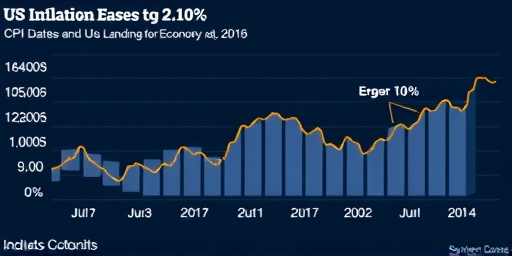In a welcome sign for the US economy, Inflation cooled to 2.1% in October, according to the latest Consumer Price Index (CPI) report from the Bureau of Labor Statistics. This marks the lowest reading since early 2021 and brings the rate tantalizingly close to the Federal Reserve’s 2% target, sparking renewed hopes for a soft landing that avoids a recession. Despite persistent higher borrowing costs from elevated interest rates, consumer spending has held firm, underscoring the resilience of American households amid cooling price pressures.
CPI Breakdown Reveals Broad-Based Inflation Decline
The October CPI data paints a picture of moderating Inflation across multiple categories, offering economists and policymakers a clearer view of the economy’s trajectory. Headline inflation, which includes food and energy prices, fell to 2.1% year-over-year, down from 2.4% in September. Core CPI, excluding those volatile components, eased to 2.6%, the smallest increase since 2021. This slowdown reflects a broader trend where supply chain disruptions from the pandemic have largely resolved, and global energy markets have stabilized post the Ukraine conflict.
Key drivers of this decline include shelter costs, which rose at a slower pace of 4.9% annually, down from peaks above 8% earlier this year. Food prices, a major concern for households, increased by just 1.6%, with grocery staples like eggs and dairy showing minimal gains. Energy prices, however, ticked up slightly by 2.1%, driven by a modest rebound in gasoline costs to an average of $3.45 per gallon nationwide. These figures suggest that while some pressures linger, the overall inflationary impulse is waning.
Economists point to the Federal Reserve’s aggressive rate-hiking campaign—now at 5.25% to 5.5%—as a pivotal factor in this cooling. ‘The CPI numbers are a testament to the Fed’s policy efficacy,’ said Dr. Elena Ramirez, chief economist at the National Economic Research Institute. ‘We’ve seen inflation retreat without the economy grinding to a halt, which is the holy grail of monetary policy.’
To illustrate the progress, consider the trajectory: Inflation peaked at 9.1% in June 2022, prompting a series of 11 rate hikes. By October 2023, the rate had halved, aligning with the Fed’s projections in their September dot plot, which anticipated two more quarter-point cuts in 2024 if trends hold.
Fed Target Nears as Central Bank Signals Potential Rate Pause
With inflation inching toward the Fed target of 2%, attention now turns to the Federal Open Market Committee’s (FOMC) next moves. Chair Jerome Powell, in recent speeches, has emphasized a data-dependent approach, but the October CPI bolsters the case for pausing further hikes. Markets now price in a 70% chance of rates holding steady at the December meeting, according to CME FedWatch Tool data.
The proximity to the 2% goal has reignited debates on the soft landing narrative—a scenario where inflation normalizes without triggering widespread job losses or a downturn. Historical precedents, like the 1990s under Alan Greenspan, show it’s possible, but today’s environment with higher debt levels adds complexity. ‘Hitting the Fed target isn’t just about numbers; it’s about sustainable growth,’ noted Mark Thompson, portfolio manager at Vanguard Investments. ‘If CPI continues this path, we could see easing as early as mid-2024.’
Supporting this optimism, labor market indicators remain robust. Unemployment held at 3.9% in October, with nonfarm payrolls adding 150,000 jobs—below expectations but still positive. Wage growth moderated to 4.1%, reducing the risk of a wage-price spiral that could reignite inflation.
Yet, challenges persist. Sticky services inflation, at 4.2%, and potential geopolitical risks, such as renewed Middle East tensions affecting oil supplies, could disrupt the downward trend. The Fed’s own projections estimate core PCE inflation—their preferred gauge—at 2.1% by year-end, slightly above CPI but converging.
Consumer Spending Resilience Shines Amid Higher Borrowing Costs
Despite the Fed’s rate hikes pushing mortgage and credit card rates to two-decade highs, consumer spending has proven remarkably durable, fueling GDP growth estimates of 2.8% for the third quarter. Retail sales rose 0.7% in October, led by gains in electronics and apparel, as households tapped into savings accumulated during the pandemic.
This resilience is evident in sectors like automobiles, where sales hit 15.5 million units annualized, buoyed by promotions despite 7.2% auto loan rates. ‘Consumers are adapting; they’re shopping smarter, not stopping,’ said retail analyst Sarah Kline from Deloitte. Online spending, via platforms like Amazon, surged 8.2%, reflecting a shift to value-driven purchases.
However, not all is rosy. Credit card delinquency rates climbed to 3.1%, the highest since 2010, signaling strain among lower-income groups. Personal savings rates dipped to 3.8%, prompting concerns about overextension. Still, high-income earners, with stock market gains from the S&P 500’s 10% yearly rise, continue to drive luxury spending, with categories like travel up 12%.
Government data underscores this split: Disposable personal income grew 0.3%, but after-tax adjustments show middle-class families feeling the pinch from elevated costs. Fiscal policies, including the end of expanded child tax credits, may temper future outlays, but for now, consumer spending anchors the soft landing hopes.
- Key Spending Categories: Housing (up 0.4%), Healthcare (up 0.5%), Recreation (up 1.1%)
- Declines: Gasoline (down 0.2%), Apparel (flat)
- Overall Impact: Contributes 70% to GDP, per BEA estimates
Economists Rally Behind Soft Landing Prospects for 2024
The October CPI has shifted the consensus among forecasters toward a soft landing, with 65% of economists in a Bloomberg survey now predicting no recession in the next 12 months. This optimism contrasts with earlier fears, when inversion of the yield curve—a reliable recession signal—prompted dire warnings.
Wall Street heavyweights echo this view. JPMorgan Chase’s research team upgraded their 2024 GDP forecast to 1.8%, citing cooling inflation as a disinflationary force without derailing hiring. ‘The soft landing is no longer a dream; it’s becoming reality,’ proclaimed CEO Jamie Dimon in a recent investor call. Goldman Sachs similarly anticipates three rate cuts starting in March, paving the way for renewed business investment.
From a global perspective, the US trend influences trading partners. The eurozone’s inflation at 2.9% and China’s sluggish recovery benefit from lower US import demand pressures. Domestically, small businesses report eased input costs; the NFIB index rose to 91.3, with 45% citing inflation as a top concern—down from 60% in mid-2023.
Challenges remain, including potential fiscal cliffs from debt ceiling debates and election-year uncertainties. If inflation rebounds due to supply shocks, the Fed might resume hikes, but current data supports de-escalation. Consumer confidence indices, like the University of Michigan’s at 63.8, reflect cautious positivity, with expectations subindex hitting 78.4—the highest since 2022.
Looking ahead, November’s jobs report and December’s FOMC meeting will be crucial. If unemployment stays below 4% and CPI trends lower, the narrative of a soft landing could solidify, encouraging corporate capex and housing starts, which have languished at 1.4 million units amid 7.8% mortgage rates.
Implications for Households and Markets in the Year Ahead
As inflation nears the Fed target, households stand to gain from stabilizing prices and potential borrowing relief. Grocery bills, which spiked 25% since 2020, may plateau, freeing up budgets for discretionary items. Homeowners refinancing at lower rates could save $200 monthly, per Freddie Mac estimates, boosting disposable income.
Markets have responded bullishly: The Dow Jones climbed 1.2% post-CPI release, while bond yields dipped, with 10-year Treasuries at 4.1%. Tech stocks, sensitive to rates, saw Nasdaq gains of 1.8%, as investors bet on AI-driven growth in a low-inflation environment.
For policymakers, success here could validate the Fed’s strategy, influencing global central banks like the ECB and BOJ. Yet, vigilance is key; persistent above-target inflation in services or renewed energy volatility could necessitate course corrections. Overall, the October data positions the US economy for steady expansion, with consumer spending as the linchpin and soft landing hopes brighter than ever.
In the coming months, watch for holiday spending data and Q4 GDP revisions, which will further illuminate whether this disinflationary path leads to prosperity or pitfalls. With the Fed target in sight, the stage is set for a pivotal 2024.









